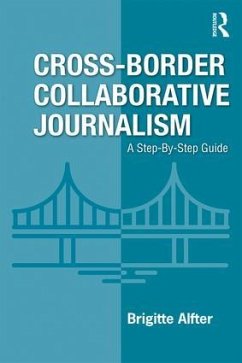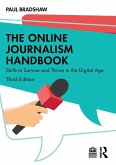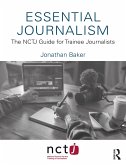Cross-Border Collaborative Journalism is a detailed guide to transnational reporting, a cutting-edge journalistic strategy. In the twenty-first century, the most pressing political and social issues, such as financial crises, wealth inequality, migration flows and environmental collapse, transcend national borders. In reaction, journalists are increasingly collaborating across the globe to produce impactful and in-depth reporting. Recent agenda-setting cross-border collaborations include LuxLeaks, Panama Papers and Football Leaks.
Brigitte Alfter takes the reader, step-by-step, through the history of cross-border collaborative journalism and the current working practices behind it. The book draws from the author's own experience, as well as exclusive interviews with other pioneers of cross-border journalism, and notable case studies are integrated throughout.
Chapters cover:
Managing intercultural communication
Effectively utilising anetwork of sources
Choosing the initial story idea
Fact-checking for cross-border publication
Adapting the findings to different audiences and to different types of media
Legal and security considerations for a cross-border team.
By providing the essential practical skills for transnational reporting, Cross-Border Collaborative Journalism encourages students of journalism and practitioners to undertake their own collaborative projects. It highlights the importance of this exciting new journalistic form to answering the defining questions of our time.
Brigitte Alfter takes the reader, step-by-step, through the history of cross-border collaborative journalism and the current working practices behind it. The book draws from the author's own experience, as well as exclusive interviews with other pioneers of cross-border journalism, and notable case studies are integrated throughout.
Chapters cover:
Managing intercultural communication
Effectively utilising anetwork of sources
Choosing the initial story idea
Fact-checking for cross-border publication
Adapting the findings to different audiences and to different types of media
Legal and security considerations for a cross-border team.
By providing the essential practical skills for transnational reporting, Cross-Border Collaborative Journalism encourages students of journalism and practitioners to undertake their own collaborative projects. It highlights the importance of this exciting new journalistic form to answering the defining questions of our time.
Alfter's book makes it clear that these days, when politics, business and crime all cross borders, journalists too need to look beyond their noses. But how does one go about selecting a cross-border topic and developing it? What's the best way of organising a professional network? How can intercultural teams be made to work smoothly? How can the findings be adapted for presentation to different audiences and in different kinds of media? Brigitte Alfter answers these questions in detail, giving lots of examples and tips based on her own experiences as a journalist and on interviews with many other journalists involved in cross-border collaborative projects ... Her book provides an easy-to-understand walk-through of all these steps, augmented with invaluable advice.
- European Journalism Observatory
We need to rethink the newsroom, journalist role and journalist education. It is clear (even more so) when you have read Brigitte Alfters excellent handbook in cross-border journalism cooperation.
The handbook is in English and easy to read, and it provides a thorough insight into how a journalist can work across borders. A large part of the strength of the book is that it challenges the traditional perception of the journalist as a lone wolf and the image of other media as competitors.
- Journalisten
- European Journalism Observatory
We need to rethink the newsroom, journalist role and journalist education. It is clear (even more so) when you have read Brigitte Alfters excellent handbook in cross-border journalism cooperation.
The handbook is in English and easy to read, and it provides a thorough insight into how a journalist can work across borders. A large part of the strength of the book is that it challenges the traditional perception of the journalist as a lone wolf and the image of other media as competitors.
- Journalisten









